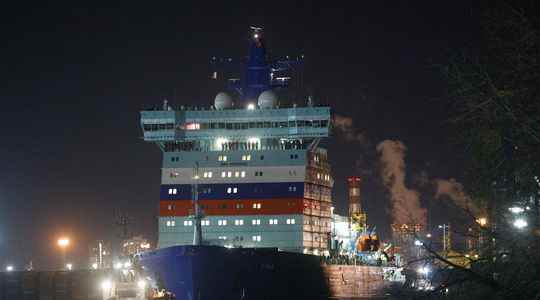He is baptized Ural, in homage to the Russian region of the Urals. Russia inaugurated this Tuesday, November 22 a new nuclear-powered icebreaker which should facilitate its hydrocarbon exports to Asia via the Arctic, at a time when Moscow is reorienting its energy strategy due to Western sanctions against its offensive in Ukraine.
This new nuclear-powered ship, more than 170 meters long and 34 meters wide, can break ice up to three meters deep. It can carry up to 54 crew members, according to Rosatom. It is the third copy of a series launched by the atomic energy giant, after the ships Arktika and Sibir, replacing aging icebreakers Yamal and 50 Let Pobedy.
“Another unique feature is its double-draft design. The ballast tanks inside the hull can be easily adjusted to change the ship’s draft depending on whether it is sailing in the Arctic Sea or in the shallow estuaries of rivers”, explained Rosatom on May 25, 2019 when it was launched, as reported the online magazine Mer et Marine.
A deployment that must ensure Russian supremacy in the Arctic
“The development of the Northern Sea Routes (NSR) will enable Russia to fully realize its export potential and establish an efficient logistics route, including to Southeast Asia,” said this Tuesday, Russian President Vladimir Putin in a speech broadcast by videoconference during the commissioning ceremony in Saint Petersburg.
“L’Ural is at the heart of our strategic plan to open the northern maritime routes to activity all year round. Our goal for 2024 is to send more than 80 million metric tons of shipments through this route,” said Alexey Likhachev, General Manager of Rosatom, during the launch of theUral in 2019. At the same time, Vyacheslav Ruksha, head of the NSR department at Rosatom, explained that “without a modern nuclear icebreaker fleet, it is impossible to imagine the development of the Northern Sea Route”, as the magazine reported the Great Continent.
Its deployment must make it possible to ensure Russian supremacy in the Arctic, a strategy assumed by Vladimir Putin, while Moscow is confronted with the ambitions of other powers. According to the Russian President, theUral will operate “from December” 2022 in the Arctic, a region where Russia produces liquefied natural gas (LNG) initially intended for Europe.
But the country, the world’s leading gas exporter and number two for oil, now wants to redirect its hydrocarbon deliveries to Asia, while the European Union has decided on a gradual embargo on its imports of Russian oil and largely reduced those in gas to protest against the Russian attack in Ukraine.
One of the routes through the frozen waters of the Arctic, the “Northern Sea Route”, is now more easily navigable due to melting ice caused by climate change. Moscow hopes that it will make it possible to increase the transport of hydrocarbons to Southeast Asia by connecting the Atlantic, Pacific and Arctic oceans.
Russia, the world’s only builder and operator of nuclear icebreakers, also launched the Yakutiafrom the same series as theUral, but its effective entry into service is only scheduled “at the end of 2024”, according to Vladimir Putin. A gigantic nuclear-powered Russian ship, more than 200 meters long, is also due to see the light of day in 2027.
